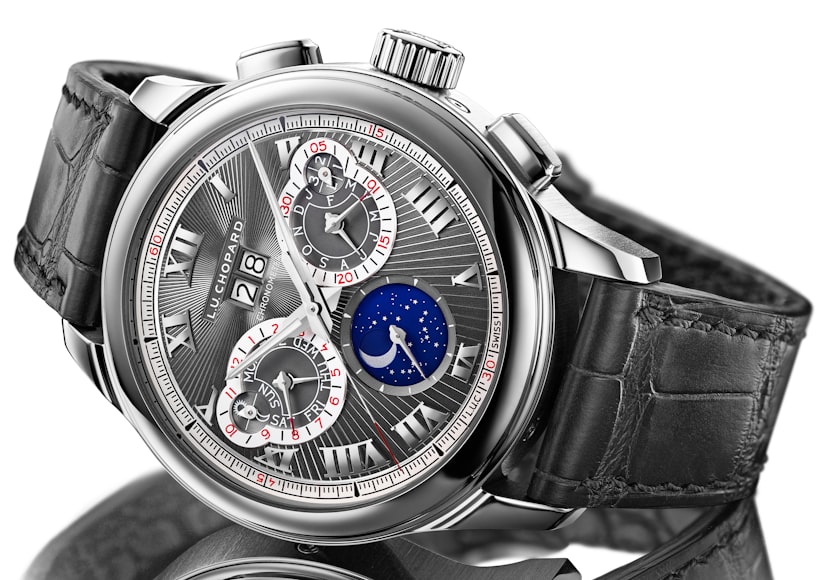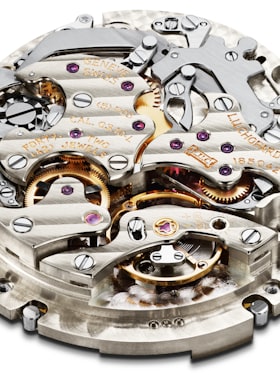Chopard is a company that began as a watchmaker, became famous as a jeweler, and then, in 1996, became famous again as a watchmaker. The company was founded in 1860; the Happy Diamonds designs debuted in 1976; and in 1996, Chopard surprised fine watchmaking enthusiasts with the introduction of its first L.U.C. movement, the caliber 1.96, from a design by none other than Michel Parmigiani. Like many enthusiasts I was first introduced to L.U.C. (the initials are those of Chopard's founder, Louis-Ulysse Chopard) by Walt Odets' Timezone article from 2002, which praised the movement as "perhaps the finest automatic movement being made in Switzerland today." In the years since then the L.U.C. family of watches has gradually expanded, and the complexity of the L.U.C. offerings has increased. This year marks an important milestone for Chopard: the release of its very first, all in-house, perpetual calendar chronograph, the L.U.C. Perpetual Chrono, a 20-piece limited edition.

The L.U.C. Perpetual Chrono has as its base a movement that is only two years old: the Chopard L.U.C. 03.07-L, which was introduced in the spring of 2014 in Chopard's 1963 Chronograph. This is a pretty high grade movement, as you'd expect from the L.U.C. line – a contemporary vertical clutch, column-wheel, hand-wound flyback chronograph movement, 5.62 mm x 28.8 mm, with a variable inertia balance (Chopard's own design) with a 60-hour power reserve, running in 42 jewels, adjusted to five positions. There's a moonphase display accurate to one day's error every 122 years. The movement carries the Geneva Hallmark and it's COSC certified as a chronometer, so it pretty much ticks all the enthusiast boxes.

The addition of Chopard's perpetual calendar works (which are, as is almost always the case, cadrature, or under-the-dial-works, and therefore not visible) has changed the dimensions of the movement slightly. Perpetual calendar chronograph movement L.U.C. 03.10-L is 33 mm x 8.32 mm – for comparison, Patek Philippe's hand-wound, non-flyback, perpetual calendar chronograph movement, CH 29-535 PS Q, is 32 mm x 7 mm with a 55-hour minimum guaranteed power reserve, as seen in the reference 5270.
The increase in movement size has meant a slight increase in the size of the Chopard Perpetual Chrono over the 1963 Chronograph – the latter clocks in at 42 mm x 11.5 mm, while the new Perpetual Chrono is 45 mm x 15.06 mm. Again, just for the sake of comparison, the Patek 5270 is 41 mm in diameter; A. Lange & Söhne's Datograph Perpetual, perhaps a closer match to the Chopard Perpetual Chrono (both are large date, perpetual calendar, flyback, hand-wound chronographs), is 41 mm x 13.5 mm. What the Chopard brings to the table, in addition to what it offers technically, is a different, more extroverted design language than either Patek or Lange, and a pretty interesting price point. The L.U.C. Perpetual Chrono at launch is priced at $85,000, which is significantly less than any of its comparable competition.


Chopard caliber L.U.C. 03.10-L is, like its chrono-only predecessor, a COSC-certified chronometer (it would be interesting to see how many chronometer-certified perpetual calendar watches are in existence or have ever been made – there can't be many). It also carries the recently updated Geneva Hallmark; the latter was formerly administered by the Geneva School of Watchmaking but since 2012, it's been under the auspices of Timelab, and includes functional, decorative, and casing up requirements. It's much more comprehensive with respect to the entire watch than used to be, and you can read about the new(ish) Geneva Hallmark requirements on their rather surprisingly slick website.

One other point worth mentioning: Chopard sources its gold with the help of Fairmined. A seldom-discussed elephant in the room in watches and jewelry is the enormous environmental impact, and social impact, of gold mining, and Fairmined works with its partners to ensure its gold comes from ethically responsible sources; you can read more about their work right here.
As we said at the top of the story, the launch of their very first perpetual calendar chronograph is a pretty big deal for Chopard, and we're looking forward to seeing the watch in-the-metal next week in Basel. The perpetual calendar chronograph, especially executed in house, and with high grade finish, is not just a complication; it's a statement of purpose and identity. Right now, just on the basis of the initial announcement this looks like potentially a very interesting alternative to some of the usual suspects in the battle for the attention of clients interested in a top-tier perpetual calendar chronograph.
The Chopard Perpetual Chrono, reference 161973-1001: Fairmined 18k white gold case, 45 mm x 15.06 mm, 30 m water resistant. Movement, hand-wound caliber L.U.C. 03.10-L, perpetual calendar, flyback chronograph, vertical clutch and column wheel controlled, variable inertia balance, COSC certified chronometer, Geneva Hallmark. High accuracy moon-phase display with one day's deviation per 122 years. Displays: hours, minutes, small seconds, large date, moonphase, center chronograph seconds, 12 hour and 30 minute counters; day of the week and leap year as well. Price will be about $85,000. Visit online at chopard.com.
No comments:
Post a Comment